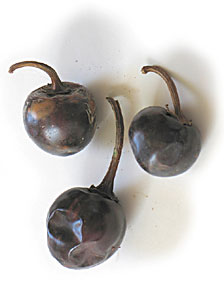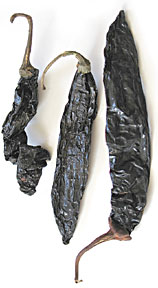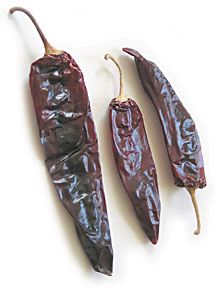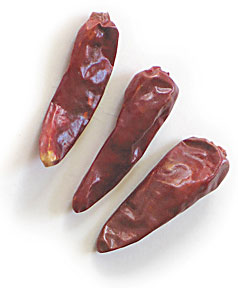|

COVER STORY | IN THE NEWS | OFF THE PAVEMENT |
BOOK NOTES
TALK OF THE TABLE | THE HUM | CALENDAR
October 26, 2006

Texas Chili
by JOSEPH
BYRD
chile photos by
BOB DORAN
Pictured top to bottom: Cascabel, Negro, California and Japones.
Twenty-three years ago,
my wife and I had lunch at a Dallas restaurant said to be the
source of the fajita: There was no sign, and I can't recall the
name, but it was in a big old house on a tree-lined residential
street a few blocks west of downtown. Most of the first floor
had been razed to make a dining hall. The place was jammed with
businessmen in suits and boots and Stetson hats. My wife might
have been the only woman there. Smoke from the grill hung in
the air. They made nothing but fajitas, and no, there was no
chicken or shrimp option, nothing but skirt steak, marinated
in lime juice and garlic, seared over a hot mesquite fire, and
chopped, presented on a hot metal platter, together with grill-blackened
scallio ns
and green chile rajas (strips). There were thick flour tortillas
and lime wedges. On the side -- not refritos, but soupy "Charro"
(cowboy style) beans in a bowl. And beer. And that was all they
served. Period. It was to be in Heaven. Except, of course, we
were in Texas. ns
and green chile rajas (strips). There were thick flour tortillas
and lime wedges. On the side -- not refritos, but soupy "Charro"
(cowboy style) beans in a bowl. And beer. And that was all they
served. Period. It was to be in Heaven. Except, of course, we
were in Texas.
God must have taken pity on Texas, which is surely
among the closest places to Hell on Earth, because the best cheap
food I've ever had was in Texas, from spectacular Southern cooking
at a cafeteria in north Dallas to addictive barbecue brisket
in a tin shack in Kilgore to magnificent French-infused Vietnamese
seafood on the Houston waterfront.
But today my topic is chili. Yup, just plain chili
-- except that those who know the broad swath this dish has carved
into the national cuisine, distinguish it from the others as
"Texas Chili."
"Texas Chili" originated in San Antonio,
sometime after the Civil War, according to John Thorne's definitive
work, Just Another Bowl of Texas Red -- now out of print,
but incorporated into his collection of food essays, Serious
Pig (North Point Press, 1996, a treasure for those who cherish
American regional cooking).
There are nearly as many chili recipes as there
are cooks. Contestants in the big national cook-offs all have
their secret processes and ingredients. Many use a combination
of beef with other meats, most often pork, though I have seen
venison, goat, mutton, chicken, duck and ostrich. And since everyone
is seeking to be "The Best," the use of offbeat and
exotic elements is inevitable, leading to absurdities like pineapple,
peanut butter or cinnamon. After all, something no one else has
thought of could be your key to first prize, and a week in Houston
in August. (Second prize: two weeks in Houston.)
 Age
has brought me to agreement with the first historian of chili
cookery, Francis Xavier Tolbert: "Keep things simple as
possible with chili. The main thing in good chili is for no one
ingredient to overpower any other. And, above all, remember that
it's not the heat but the taste that counts." Age
has brought me to agreement with the first historian of chili
cookery, Francis Xavier Tolbert: "Keep things simple as
possible with chili. The main thing in good chili is for no one
ingredient to overpower any other. And, above all, remember that
it's not the heat but the taste that counts."
About once every nine months I make and freeze
a batch of chili. Over the years, we've assembled nearly half
a freezer of dried whole chiles from "Native Seed Search"
in Tucson. Each has its distinctive flavor: Aji Amarillo,
with a tart citrus nose; Chimayo, with its bitter edge.
Smoky Chipotle, mellow Ancho. And Hatch,
the archetype of sweet New Mexico chiles. When it's time to make
a batch, I usually improvise a combination. For local first-timers,
try El Pueblo Market on lower Broadway in Eureka or Rita's new
deli in Arcata behind the Co-op. I'd advise at least three varieties
of dried chiles.
Chili purists insist that ground beef is not
an option; it must be minced with a knife. (Historically, that's
true: There were no meat grinders in 1870s San Antonio). I ignore
this, usually combining ground fresh chuck, half regular and
half coarse. Regular absorbs the flavors better. Course provides
a meaty texture. My butcher is sympathetic. I use Painted Hills
beef, available at Murphy's Markets.
The meat is put into a marinade of dark bitter
stout overnight. There is a dark beer called "Pete's Wicked
Ale" which I find nasty and undrinkable, but it's perfect
for this purpose.
Cooking day: Drain the meat, but reserve the liquid.
In a heavy pot, sauté minced onion (not too much
-- this is not a stew), garlic (lots of it) and bell pepper (a
"secret ingredient" which adds a subtle note of sugar)
-- ideally in melted beef suet, though bacon grease or peanut
oil is OK. Add the meat and cook until there's no more pink.
Strong, left-over French-press coffee is the best simmering liquid.
(This is our little secret; please tell no one.)
Now it's time to add chiles. Oops, we should have
already prepared them ... but no harm done, because the pot is
just on low simmer. The whole chiles should be cast-iron pan-roasted
on high heat, turning, until they blacken a bit, puff up and
give off smoke, then liquefied by blending with remaining marinade
or coffee -- never use water. If you want less heat, remove the
seeds.
If whole chiles are too much effort, you may use
chile powders (but surely not anything you'll find on supermarket
shelves; besides El Pueblo, Murphy's Market in Sunnybrae has
started to carry some Mexican spices, and again, Rita's in Arcata.)
The other required spices are likewise pan-roasted:
cumin and Mexican oregano, plus one bay leaf per pound of meat.
Add some "masa harina" (the fine corn meal used for
tortillas) mixed with oil to make a roux, as a thickener. Use
a small amount of tomato paste toward the end, to "set the
flavors," as the old-timers say, but do not add tomato puree,
as tomato will destroy chili (note that tomato is the predominant
flavor in "vegetarian chili"). Some ground pepper can't
hurt. Go gentle with the salt.
At this point, Faith is required. And Patience.
Resist the temptation to cook chili too long: 2 hours after everything
is in the pot is about right; 3 hours max. Stir from time to
time, scraping the bottom. Simmer, don't boil. There will be
grease on top. Live with it. (If you really don't want
it in the chili, spoon it off; it is a superlative flavored oil
for all manner of stir-frys.)
Now comes the hard part. Never, ever, eat chili
the day you make it. For the same reason, tasting as you go doesn't
work, except maybe for salt. It will never taste "right,"
and futzing won't help. Trust me. At worst, it won't be bad,
and you will learn how to improve the next bat ch. At best, it will be magic. ch. At best, it will be magic.
(Oh, yeah. Remember "Chili Cook-offs"?
Well, every chili contest I've heard of gives contestants from
about 10 in the morning until 3 in the afternoon; then the chili
is presented and judged. Which means nobody in that contest
is making anything that comes close to good chili. The only way
to have good chili in a contest is to smuggle in containers of
the stuff you made yesterday! Do people really do that? They
do indeed.)
This is authentic Texas chili, pretty close to
the way it was in the beginning: tough cuts of marinated steer,
minced and simmered with lots of garlic, toasted spices and black
coffee. Of course, what do we really know about "authentic"?
No records were kept by the San Antonio "Chili Queens"
who first made this dish as street food. This was, after
all, fast food for working-class men: cowhands and soldiers,
in town for a quick lay at the local brothel, then getting drunk
as thoroughly and cheaply as possible.
Oh yeah. Please don't add beans to chili:
They destroy the essential intense meat experience. Don't even
serve them on the side; they are bound to end up mixing with
the chili in the mouth. Probably the original was sopped up with
thick hand-patted corn tortillas. So choose an accompaniment
bland and filling, like rice (East Texas style), grits (Deep
South) or polenta. Spaghetti works fine (authentic Depression
Era). My own favorite is cornbread. With it, serve a simple salad,
with a tangy/sour, not-too-rich dressing. Slaw is perfect.
You may note that I've provided no quantities for
the ingredients. This is not an accident. Every batch is different.
If you've persevered this far, you will find your own path.
For whole dried chiles (and chile powders and
smoked chiles), visit Native Seeds/SEARCH (nativeseeds.org) and click on "Food."
Also, I consider Chihuahuan wild desert oregano critical (under
"Herbs") since Italian oregano adds a "spaghetti
sauce" flavor.

your
Talk of the Table comments, recipes and ideas to Bob Doran.
COVER STORY | IN THE NEWS | OFF THE PAVEMENT |
BOOK NOTES
TALK OF THE TABLE | THE HUM | CALENDAR
Comments? Write a
letter!

© Copyright 2006, North Coast Journal,
Inc.
|